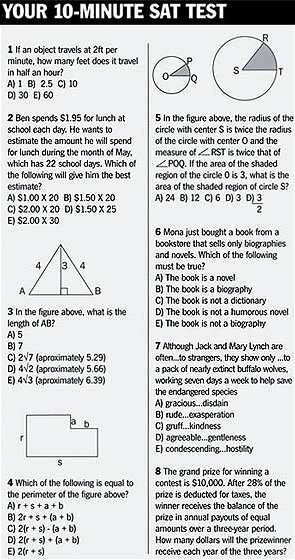|
||
|
|
Most universities in America rely on the SAT, the Scholastic Aptitude Test,
as to whether to accept a student or not. As there is no national testing like in Britain (A'level)
or Germany (Abitur), the SAT largely determines university entry in the United States. There was broad correlation between good SAT results and good A'level results with students from independent schools. A good SAT result is a score of 1,200 points. Such a score would be necessary for a student to be accepted by Harvard. 30 pupils out of c. 600 from poorly performing state schools also achieved the magic 1,200 points and-what is surprising- their SAT results and their A'level results were enormously different. 4 out of those 30 achieved only the equivalent of 3 E-grades. From The Sunday Times of March 4, 2001 Answers at the bottom Does this mean that pupils with low grades from state schools are let down by poor teaching? Are their talents not detected by their teachers? Or would they perform better if they were more challenged? In America this test is sometimes administered already with students at the age of 15 or 16 (a year earlier than normal) in order to encourage those students who might otherwise not consider universtiy. A college advisor in L.A. says, 'It (=the test) can be used as a sort of early intervention to prevent bright children from giving up and flunking out'. It would be interesting to have a similar test in Germany, not as a substitute to our 'Abitur', but as a complement to it. Answers: 1E, 2C, 3C, 4E, 5A, 6C, 7C, 8-2400 |
| © 1997-2025 englischlehrer.de × Alle Rechte vorbehalten. × Ausgewiesene Marken gehören ihren jeweiligen Eigentümern. englischlehrer.de übernimmt keine Haftung für den Inhalt verlinkter externer Internetseiten. 5.052 (+0)pi × search powered by uCHOOSE |
|

